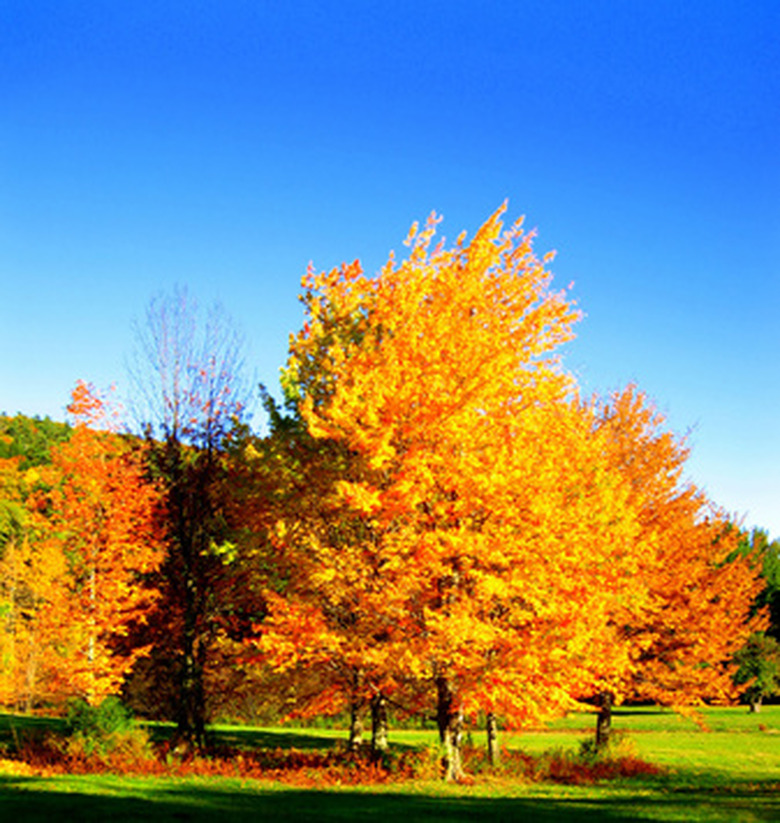Maple Tree Leaf Diseases
Maple trees are often under a great deal of stress when planted in suburban settings due to urban pollution, soil disturbance and urban growth. The stress can weaken the tree and make it more susceptible to a wide range of diseases. When a maple tree begins to decline it is often simply referred to as "maple decline," according to the University of Rhode Island. Most maple tree diseases can be avoided by offering the tree ample nutrition and care throughout its lifetime.
Phyllosticta (Phyllosticta minima)
Phyllosticta (Phyllosticta minima) causes spots to appear on the maple tree's leaves. Spots commonly appear either singular or irregular in appearance. The coloring is normally a dark brown to a tan. The margin of the spots usually appears darker than the center. Often darker, black spots appear within the main spot. If the infection is severe and widespread then the infected leaf will die and fall from the tree. Trees are infected in the early spring by airborne spores. It is imperative that infected leaves be promptly raked up and removed from the area to prevent the spread of the disease to other trees. Bordeaux fungicides can be used to gain control of the disease.
- Maple trees are often under a great deal of stress when planted in suburban settings due to urban pollution, soil disturbance and urban growth.
- It is imperative that infected leaves be promptly raked up and removed from the area to prevent the spread of the disease to other trees.
Tar Spot (Rhytisma acerinum)
Tar spot (Rhytisma acerinum) normally afflicts young trees in wet years. The fungus is spread by the wind to new and emerging foliage. The disease produces yellow or green spots on the tree's leaves. The appearance of the spot is normally wrinkled and looks like a scab. The disease rarely kills a tree but can result in intense defoliation in some cases. All leaves should be promptly raked up and disposed of to prevent the spread of the disease to healthy trees. Bordeaux fungicides and liquid copper normally prove effective against this disease.
- Tar spot (Rhytisma acerinum) normally afflicts young trees in wet years.
- The disease rarely kills a tree but can result in intense defoliation in some cases.
Anthracnose Leaf Blight (Discula sp.)
Anthracnose leaf blight (Discula sp.) causes leaf spotting that appears in dry, irregular patterns and occurs along the veins of the foliage. The fungus is damaging to leaves but poses no great threat to the maple tree's overall health. The foliage does become unsightly. The fungus is carried each spring by the wind from infected leaves. Fungus treatment can prove effective when started prior to leaf emergence. Fungicides thiophanate-methyl, chlorothalonil and mancozeb work well against anthracnose.
- Anthracnose leaf blight (Discula sp.)
- Fungus treatment can prove effective when started prior to leaf emergence.
Leaf Scorch
Leaf scorch of the maple tree is believed to be caused by the environment. Nutritional deficiencies, soil problems, salt, drought and other toxins cause the maple tree's leaves to begin drying. The margins of the leaves will appear brown but the inside of the leaf often remains green. Leaf drop is common. Diseased areas should be pruned to reduce the spread of the problem. The source of the situation needs to be discovered and rectified in order to restore overall health to the maple tree. Extensive watering of the tree can help the situation. Proper fertilizing is also important.
- Leaf scorch of the maple tree is believed to be caused by the environment.
